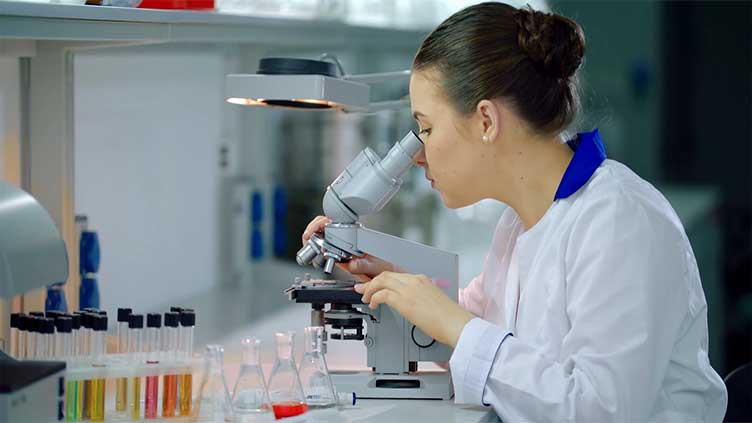Why are scientists growing human brain cells in the lab?

Why are scientists growing human brain cells in the lab?
ISLAMABAD, (Online) - Organoids — tissue cultures that roughly replicate the functions of an organ — allow researchers to observe how cells behave in tissues in vitro, in the lab. This is particularly helpful when it comes to investigating the brain and the conditions that affect it. But what are some of the ethical challenges?
Design by MNT; Photography by Yves Forestier/Getty Images & Noel Hendrickson Photography/Getty Images.
One of the greatest breakthroughs that have occurred in the past decade has been the ability to influence adult stem cells to differentiate to create certain cell types.
After conception, the cells that make up an embryo are totipotentTrusted Source, and can turn into any cell type the body requires in order to develop a full human. “Embryonic cells within the first couple of cell divisions after fertilization are the only cells that are totipotent,” explains New York State Stem Cell Science.
This property narrows throughout development and as a human ages, but the body retains some stem cells throughout its life.
Adults have stem cells in their bone marrow, which allow them to create many types of blood cells. This is known as multipotencyTrusted Source, which is crucial to allowing the immune system to stage a response to infection, for example.
While they are able to differentiate into many different cell types, multipotent stem cells are not able to differentiate into all the different cells types that form the adult body.
Stem cell research and organ models
Being able to harness the ability to control the destiny of a stem cell has allowed researchers to investigate the minutiae of how our cells work in the lab, and arguably more ethically and practically than can be done in humans or animal models.
Much research has been done into exactly how to turn one type of cell into another one, and is ongoing. Already blood and skin cells can be taken from a person and exposed to certain chemicals and media that allow them to regain their pluripotencyTrusted Source, the ability to develop into any cell type.
Called induced pluripotent stem cells, researchers are currently pursuing two main lines of work using this approach. They have created embryo models using fibroblasts, a type of cell found in the skin, for example. Recently created embryo models have allowed researchers to observe the beginning of organogenesis in the laboratory.
Organoids are particularly useful when they can be used to create models of organs or tissues which cannot be easily replicated any other way. The brain is an example of this being highly risky and difficult to biopsy in comparison to the skin, for example.
The other line of work involves the creation of organ or tissue models known as organoids. These allow scientists to investigate how certain cell types function, and can even be used to model whole organs.
In fact, the first cerebral organoid was made from induced pluripotent stem cells from a patient with microcephaly, where the size of the brain is reduced.
Researchers working with Dr. Madeline Lancaster used this model to discover that premature neuronal differentiation was likely to be the cause behind the reduced size of the brain they had observed in the patient, and published the results in NatureTrusted Source.
This finding showed for the first time that brain cells could be created from induced pluripotent stem cells, and could provide insight into the way the brain functioned and the mechanisms underpinning disease.
Recent developments
Since these initial organoids were developed, the complexity of the brain organoids created and the information that has been gleaned from them has increased. Researchers have been able to observe that induced pluripotent stem cells are able to self-organize into structures similar to those that exist in animals and humans.
Brain organoids created from induced pluripotent stem cells allowed to mature for 60 days formed optic cups, or indentations where eyes would form, a paper published in Cell Stem Cell outlined last year.
Similarly, a study published in NatureTrusted Source last year demonstrated cellular changes in cortical organoids after 250-300 days in vitro (approximately 9 months), that mimicked those observed in newborns.
The ability to model fetal brain development in the laboratorty has also allowed for greater clarity to be obtained about the impact of different drugs on brain development in utero.
The sodium valproate scandal is a worldwide scandal that saw pregnant women who had epilepsy receiving a drug to treat it that caused serious learning disabilities in the children they had who were exposed to the drug in the womb.
Recently, a study published in PLOS Biology used human cell-derived organoids to show that the drug caused accelerated aging and death in neuroepithelial cells of the brain, explaining some of the symptoms seen in affected children.
Others are hopeful that organoids could be used to model diseases. They were used to investigate the effect of SARS-CoV-2Trusted Source, the virus that causes COVID-19, on the brain to gain insight into its effects during initial infection and beyond, and some research has been done to model Alzhiemer’s, schizophreniaTrusted Source, and autismTrusted Source.

